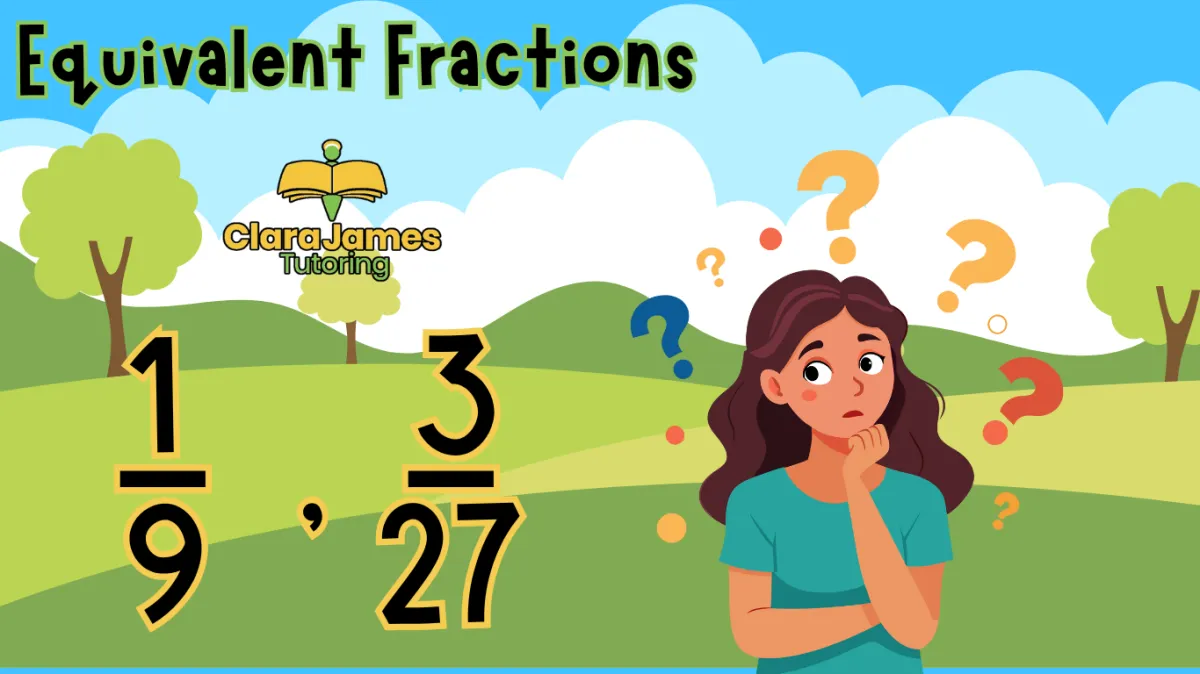Clara James Tutoring
BLOG POSTS

How to work out Equivalent Fractions
Fractions are something that a lot of people from primary through GCSE struggle with
I thought I will add the foundations of the explanation here (it goes on for a while which is why I haven’t bored you with all of it, but shout if you do want it (It will eventually all appear in the Clara James Approach and the 11+ resources).

A fraction is a bit of something. I would suggest a piece of cake, but I was working with someone once and used that as my description, and he got locked onto the fact that the cake might crumble...
Actually, we’ll say we have a piece of cake regardless. It’s been cut into 8 equal parts. That 8, is the number that goes at the bottom of the fraction, the DENOMINATOR In effect, it tells us how many we have.
Imagine, 2 pieces of cake are eaten.
That means that 2/8 of the cake are eaten, or we have 6/8 of the cake left. (Because 8-2 leaves us with 6 pieces).
If all bar one of the pieces were eaten, we’d have 1/8 left and 7/8th eaten.
If you are asked to colour in ¼ of a repeating pattern, you would group four parts and just colour in 1 of them doing this repeatedly until all the parts are complete.
I hope that makes sense so far. Please do ask if not.
Next, we might be asked about equivalent fractions.
Imagine now that my cake is cut into 2 pieces. You can have a piece and I will also have a piece. We each get 1 piece out of 2 (1/2).
But 2 more friends turn up, so we cut it down into 4 equal pieces. However, they don’t want any, so instead of us having 1 big piece each, we get 2 pieces out of 4 each (2/4)
1 = 2
2 4
Because we doubled the 1 to get to two, we had to double the 2 as well.
If we multiply or divide the top and bottom numbers by the same amount, we will keep them equivalent. This is also how we simplify.
If we had the example:
6
12
Both can be divided by 6
6/6=1
12/6 =2
Giving us an equivalent fraction of ½
If the numbers are bigger, you may break it down into smaller steps. In this example you might have halved both numbers first, then divided them both by 3.
In other examples you might have divided by 5 or 10 first to keep it simple, then as the numbers got smaller and more manageable, you can start diving by the numbers you are less confident with.
I hope this makes sense.

If you have a child who enjoys learning through games and being more creative, and you enjoy spending time with them, you might be interested in the Clara James Approach, the membership group we have put together to support you in supporting your primary school aged child with their maths and English.
Interested?
Click here to learn more: The Clara James Approach
Morning,
I hope the week is going well.
So many people seem to be doing D of E and work experience
at the moment, good luck if that’s you and if you’re at Marlow Camp next
fingers crossed for good weather!
I’ve just finished a lesson on division. It seems to be
something that messes with the brains of so many people.
I found it got easier when I stopped thinking about it as
division and instead thought about it as multiplication. So, if for example I
had the question 396 divided by 3, I would look at it as 3x what = 3. My answer
would be 1. How many times would I need to multiply 3 to get to 9, (my answer
would be 3). Then 3x something = 6. My answer would be 2. Giving me the overall
answer of 132.
I know that’s a really simple example but hopefully it explains
my point.
Thankfully in schools they don’t often seem to need to do
long division, but I’ve worked with a couple of adults (generally nurses for
some reason) who have needed it.
I think I’ll explain this one in a video, as it will be too
complicated to explain it with words as bits get put all over the place. I hope
this makes sense though:
Enjoy the rest of the week and speak soon,
Dawn

